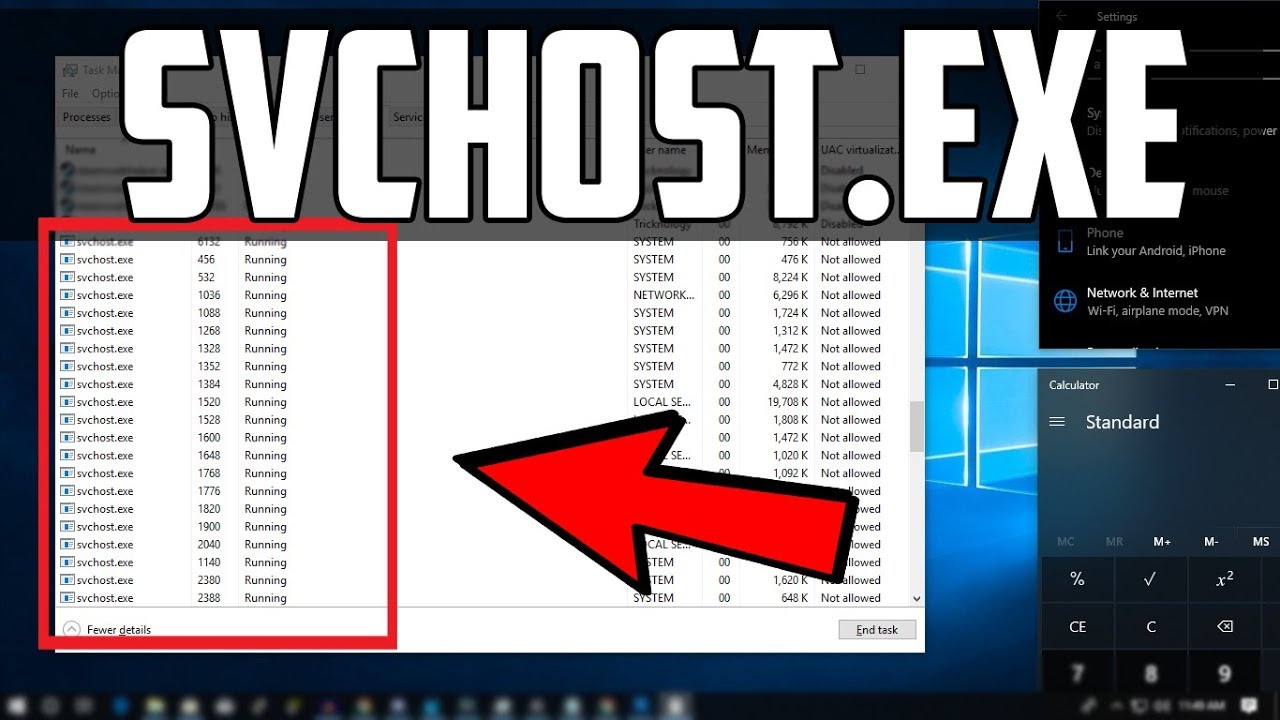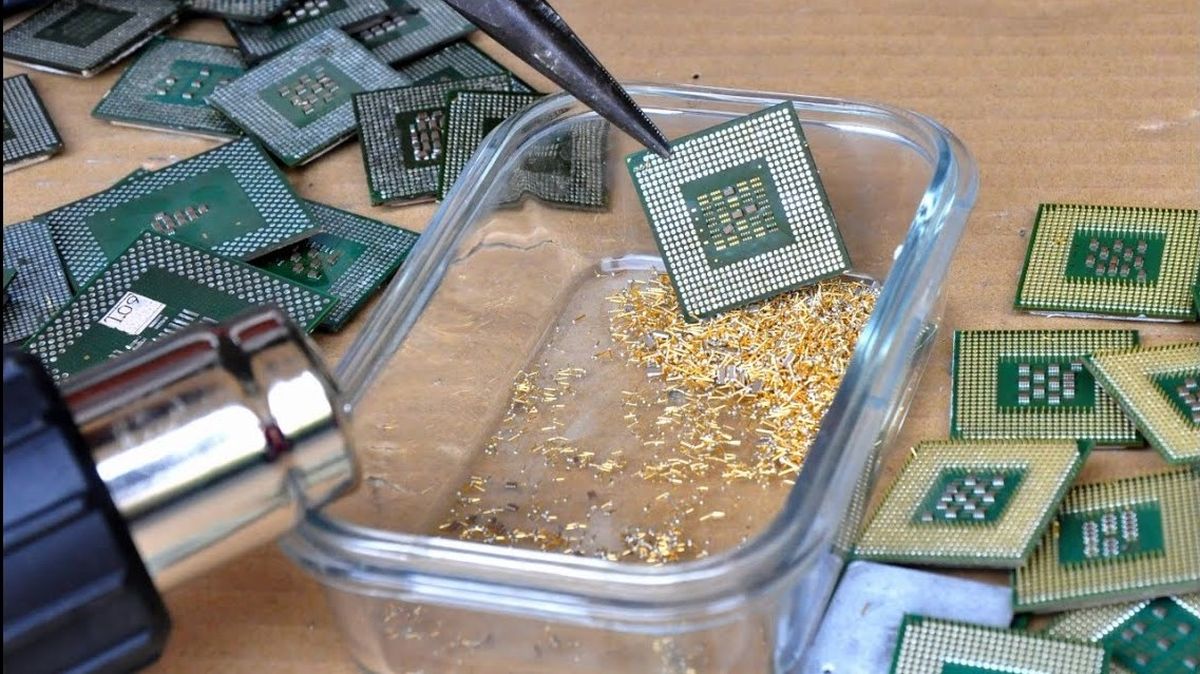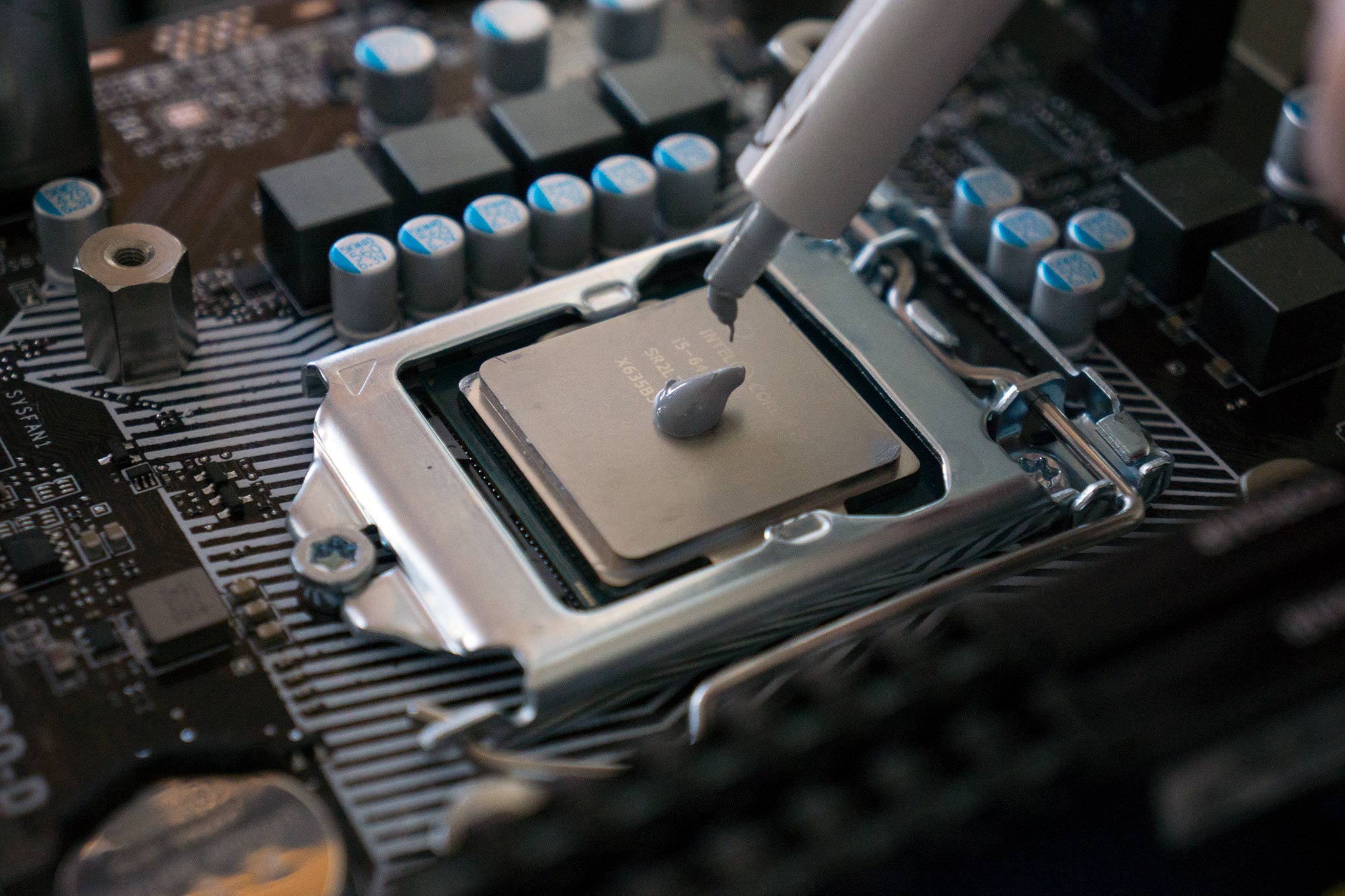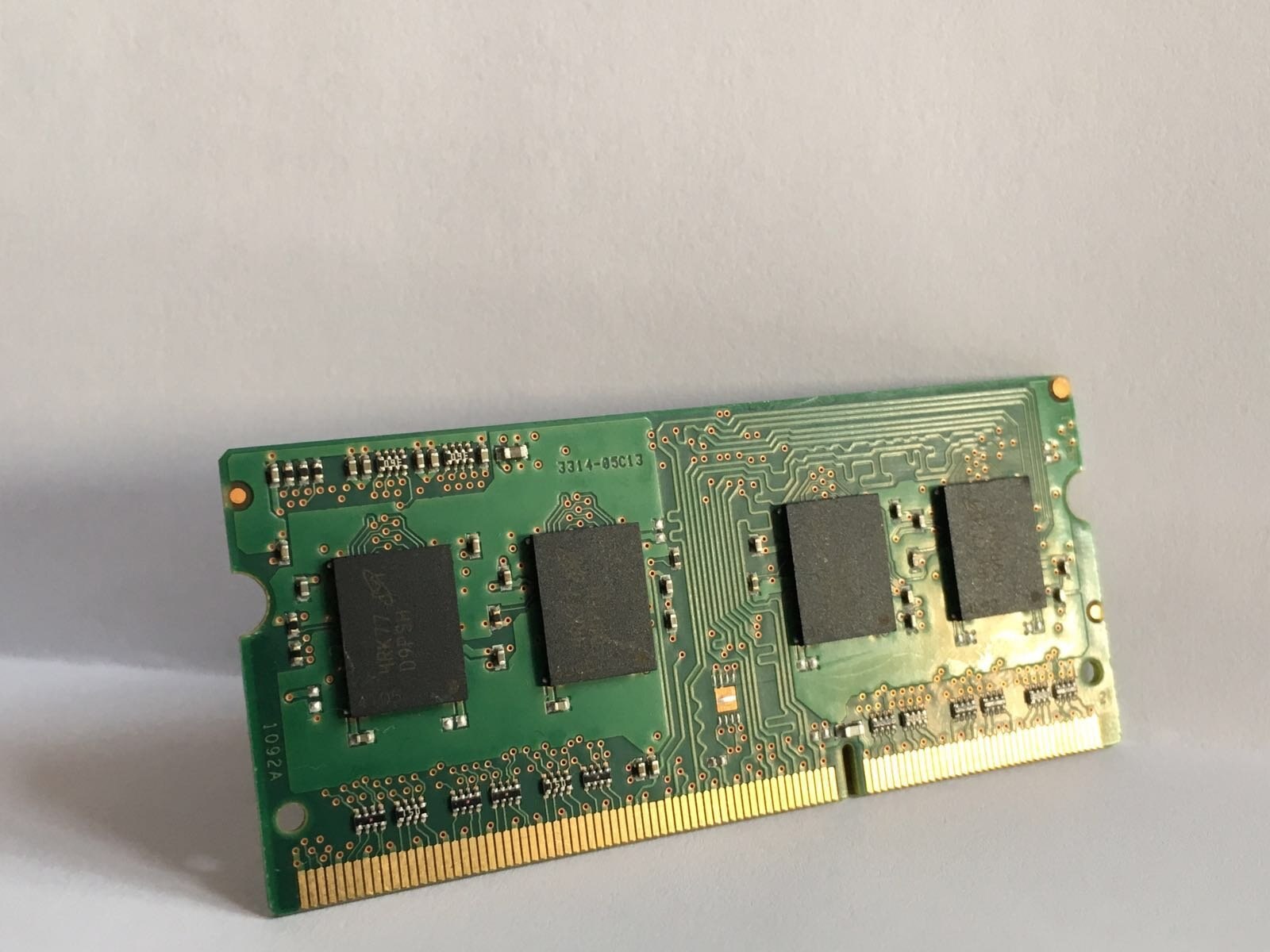Introduction
Have you noticed your computer’s fan spinning at high speed and your system running slower than usual? One common culprit behind this issue is the process called Svchost. If you ever checked the Task Manager, you might have observed that Svchost is consuming a significant amount of CPU resources. This can be frustrating and affect the overall performance of your computer.
So, what exactly is Svchost and why does it use so much CPU? In this article, we will delve into the details, explore the reasons behind Svchost’s high CPU usage, and provide effective solutions to resolve this issue.
Svchost, short for “Service Host,” is a crucial component of the Windows operating system. It helps to launch and run various services required for the proper functioning of your computer. Instead of each service running as a separate process, Svchost groups them together, making it more efficient.
The CPU, or Central Processing Unit, is the brain of your computer. It performs all the calculations and executes tasks. When Svchost starts consuming excessive CPU resources, it indicates that there might be an underlying issue with one or more services running on your system.
Understanding the reasons behind high CPU usage by Svchost is essential in order to find the appropriate solution. In the following sections, we will explore some common factors that can cause Svchost to use up a considerable amount of CPU resources.
What is Svchost?
Svchost, short for “Service Host,” is a critical process in the Windows operating system that acts as a host for multiple Windows services. Instead of each service running as a separate process, Svchost groups them together, improving efficiency and reducing system overhead.
When you open the Task Manager on your computer, you may notice multiple instances of Svchost running simultaneously. This is because each instance of Svchost can host several services related to different aspects of Windows functionality.
So, why does Windows use Svchost instead of running services as stand-alone processes? The primary reason is that Svchost allows for better resource management. By grouping similar services, Windows can allocate and share system resources more efficiently. This approach reduces the overall memory and CPU usage, ensuring smoother and more stable system performance.
Each instance of Svchost is identified by a unique process ID (PID) and runs in the background, typically with elevated permissions. The Svchost process itself is essential for the proper functioning of Windows, as it enables various services and processes to run seamlessly.
It is worth noting that there are different “hosts” for Svchost in the Task Manager, such as LocalService, NetworkService, and System. These hosts indicate the specific type of services being managed by Svchost, based on the security context under which they operate.
While Svchost is a critical component of the Windows operating system, high CPU usage by Svchost can be a cause for concern. It can slow down your computer, drain its battery life, and impact overall performance. In the next section, we will explore the reasons behind Svchost’s excessive CPU usage.
Understanding CPU Usage
The CPU, or Central Processing Unit, is the main component responsible for executing instructions and performing calculations on your computer. It is essentially the brain of the system, handling all the processing tasks required to run applications and ensure smooth functionality.
CPU usage refers to the percentage of the CPU’s capacity being utilized at any given time. It indicates the workload and efficiency at which the CPU is processing tasks. When the CPU usage is high, it means that the processor is working hard to handle the demands placed upon it.
Monitoring CPU usage is important to ensure optimal system performance. Normal CPU usage varies depending on the specific tasks and applications running on your computer. In general, a CPU usage of around 20-30% during normal operation is considered acceptable. However, if the CPU usage consistently exceeds 70-80%, it can indicate a problem that needs to be addressed.
High CPU usage can cause your system to slow down, become unresponsive, and even lead to overheating issues. It can be particularly concerning when Svchost, the Service Host process, utilizes a significant portion of the CPU, as it can impact the performance of your computer and disrupt your workflow.
Identifying the reasons behind high CPU usage by Svchost is crucial for troubleshooting and resolving the issue. In the next section, we will explore some common factors that can contribute to Svchost using up excessive CPU resources.
Reasons why Svchost uses so much CPU
There are several potential reasons why Svchost may consume a significant amount of CPU resources on your computer. Understanding these factors can help identify the underlying cause and find an appropriate solution. Here are some common reasons why Svchost uses a high amount of CPU:
- Windows Updates: One of the most common reasons for high CPU usage by Svchost is Windows Updates. Svchost acts as a host process for various Windows services, including the Windows Update service. When Windows is downloading or installing updates, Svchost can consume a substantial amount of CPU resources. This is temporary and usually resolves once the update process is complete.
- Malware or Virus infection: Malware or virus infections can also cause Svchost to use excessive CPU resources. Some malicious software can disguise themselves as Svchost processes and run in the background, consuming your system’s CPU power. Performing a thorough scan for malware and viruses is essential to address this issue.
- Incompatibility with third-party software: Sometimes, certain third-party software installed on your computer can conflict with Svchost and cause it to use more CPU than necessary. This can happen due to compatibility issues or poorly optimized software. In such cases, identifying and removing the problematic software can help resolve the high CPU usage issue.
- Corrupted system files or drivers: Corrupted system files or drivers can also lead to Svchost using excessive CPU. When essential system files or drivers are corrupted, it can disrupt the functioning of Svchost and result in higher CPU usage. Running system file checks and updating drivers can help address this problem.
- Background services running excessively: Svchost hosts a wide range of services that run in the background, supporting various functionalities of the Windows operating system. If any of these services are misbehaving or running excessively, it can cause Svchost to use a significant amount of CPU power. Identifying and managing problematic services can help mitigate excessive CPU usage.
Now that we have explored the potential reasons behind Svchost’s high CPU usage, the next section will provide effective solutions to fix this issue and optimize your computer’s performance.
Windows Updates
Windows Updates are crucial for the security and stability of your computer. However, during the update process, Svchost may utilize a significant amount of CPU resources, causing high CPU usage. This is because Svchost acts as a host process for the Windows Update service, which manages the download and installation of updates.
If you notice Svchost using excessive CPU due to Windows Updates, there are a few steps you can take to address this issue:
- Allow updates to complete: In most cases, Svchost’s high CPU usage during Windows Updates is temporary. It is advisable to let the update process continue uninterrupted. This allows Windows to download and install the necessary updates, after which the CPU usage should return to normal.
- Check for stuck or failed updates: Sometimes, Windows Updates may get stuck or fail to install properly, leading to persistent high CPU usage by Svchost. To resolve this, open the Windows Update settings and check for any updates that are stuck or failed. You can try restarting the update process or using Windows Update troubleshooter to fix any issues.
- Change Windows Update settings: If you frequently experience high CPU usage by Svchost during Windows Updates, you can modify the Windows Update settings to minimize disruptions. For example, you can choose to schedule updates for a time when you’re less likely to be using your computer, or you can select the option to notify you before downloading and installing updates.
- Consider manual updates: If you prefer more control over the update process, you can manually download and install Windows Updates from the official Microsoft website. This allows you to choose which updates to install and can help avoid any potential conflicts or issues that may contribute to high CPU usage by Svchost.
By following these steps, you can effectively manage the impact of Windows Updates on Svchost’s CPU usage and ensure a smoother update process on your computer.
Malware or Virus Infection
Malware or virus infections can cause Svchost to use an excessive amount of CPU power. Some malicious software can disguise themselves as Svchost processes and run in the background, consuming valuable system resources. This can lead to high CPU usage and significantly impact the performance of your computer.
If you suspect that malware or a virus is causing the high CPU usage by Svchost, here’s what you can do to address the issue:
- Scan your computer for malware: Run a comprehensive scan with a reliable antivirus or anti-malware program to detect and remove any malicious software present on your system. Ensure that your antivirus software is up to date with the latest virus definitions to enhance its effectiveness in identifying and eliminating threats.
- Use specialized malware removal tools: In addition to your regular antivirus software, consider using specialized malware removal tools that can target specific types of malware or employ advanced detection techniques. These tools can help identify and remove stubborn threats that may be causing high CPU usage.
- Enable real-time protection: Ensure that real-time protection is enabled in your antivirus software settings. This feature actively monitors your system for potential malware or virus activity, providing an additional layer of protection against threats that can cause high CPU usage by Svchost.
- Practice safe browsing habits: Prevent future malware or virus infections by practicing safe browsing habits. Avoid clicking on suspicious links, downloading files from untrusted sources, and opening email attachments from unknown senders. These precautions can help minimize the risk of encountering malicious software that can impact CPU usage.
- Consider professional help: If you are unable to resolve the high CPU usage issue caused by malware on your own, consider seeking professional assistance from a reputable computer repair service or IT expert. They can perform advanced malware removal techniques and provide further guidance in securing your system.
By taking these steps, you can effectively detect and remove any malware or virus infections that may be causing Svchost to use excessive CPU resources. This will not only enhance the performance of your computer but also ensure the safety and security of your data.
Incompatibility with Third-Party Software
In some cases, Svchost may use a significant amount of CPU due to compatibility issues with third-party software installed on your computer. Certain software applications may conflict with Svchost, causing it to consume more CPU resources than necessary. This can lead to degraded system performance and higher CPU usage.
If you suspect that incompatibility with third-party software is causing Svchost’s high CPU usage, here are some steps you can take to address the issue:
- Identify the problematic software: Start by identifying the specific third-party software that may be causing the compatibility issue. This can be done by observing the CPU usage patterns in the Task Manager when the high CPU usage occurs. Pay attention to any software applications that coincide with the spike in CPU usage.
- Update or reinstall the software: Check if there are any updates available for the problematic software. Developers often release updates to address compatibility issues and improve overall performance. If an update is available, install it and see if it resolves the high CPU usage problem. Alternatively, you can try reinstalling the software to ensure a fresh installation.
- Disable or uninstall conflicting software: If updating or reinstalling the software doesn’t resolve the issue, consider disabling or uninstalling the conflicting software altogether. This may involve temporarily removing the third-party software from your computer to determine if it is indeed causing the high CPU usage. If the CPU usage returns to normal after disabling or uninstalling the software, it confirms that the software was the cause of the problem.
- Look for alternative software: If disabling or uninstalling the conflicting software is not a viable option, consider finding alternative software that provides similar functionality. Look for software applications that are known to be compatible with your operating system and have positive user reviews. This can help ensure a smoother experience with reduced CPU usage.
- Reach out to the software developer: If none of the above steps resolve the compatibility issue, you can reach out to the software developer for assistance. Contact their support team or explore their online forums for solutions. They may be able to provide specific guidance or updates to address the compatibility problems.
By following these steps, you can address the issue of high CPU usage by Svchost caused by incompatibility with third-party software. This will help optimize your computer’s performance and ensure smoother operation.
Corrupted System Files or Drivers
Corrupted system files or drivers can contribute to Svchost using an excessive amount of CPU. When essential system files or drivers become corrupted, it can disrupt the functioning of Svchost and result in higher CPU usage. Resolving the issue requires identifying and fixing the corrupted files or drivers.
Here are some steps you can take to address high CPU usage by Svchost due to corrupted system files or drivers:
- Run System File Checker (SFC): The System File Checker is a built-in Windows tool that scans for and repairs corrupted system files. Open a Command Prompt as an administrator and run the command “sfc /scannow”. This will initiate the scanning process and automatically repair any corrupted system files it finds.
- Check for driver updates: Outdated or faulty drivers can lead to Svchost using excessive CPU resources. Visit the website of your computer manufacturer or the specific hardware component manufacturer and check for driver updates. Download and install any available updates to ensure your system is using the latest, compatible drivers.
- Use Device Manager to uninstall and reinstall drivers: If updating the drivers does not resolve the issue, you can use the Device Manager to uninstall and reinstall problematic drivers. Open Device Manager, locate the device with the faulty driver, right-click on it, and select “Uninstall device”. Restart your computer and Windows will automatically reinstall the driver.
- Perform a system restore: If you suspect that recent changes or installations have caused the corrupted files or drivers, performing a system restore can help. This will revert your computer’s configuration to a previous state where the issue was not present. Open the System Restore tool and choose a restore point before the problem started occurring.
- Consider a clean installation of Windows: If all else fails, and the issue persists, you may need to consider a clean installation of Windows. This will wipe your computer’s hard drive and reinstall Windows from scratch. Be sure to back up your important files before proceeding with a clean installation.
By following these steps, you can effectively address the issue of high CPU usage by Svchost caused by corrupted system files or drivers. This will help restore system stability and optimize the CPU usage on your computer.
Background Services Running Excessively
Svchost acts as a host for various background services on your computer, ensuring the smooth operation of the Windows operating system. However, certain services may misbehave or run excessively, leading to high CPU usage by Svchost. Identifying and managing these problematic background services is crucial to resolve the issue.
Here are some steps you can take to address high CPU usage by Svchost caused by excessively running background services:
- Identify the problematic service: Start by identifying the specific service that is causing the high CPU usage. This can be done by monitoring the Task Manager and noting any services hosted by the Svchost process that continuously consume a large amount of CPU resources.
- Stop or disable the service: Once you have identified the problematic service, you can try stopping or disabling it to mitigate the high CPU usage. Open the Services Management Console by pressing Windows key + R, typing “services.msc”, and pressing Enter. Locate the service, right-click on it, and choose to stop or disable it. However, exercise caution when disabling services, as some may be essential for the proper functioning of your computer.
- Modify the service’s startup type: If stopping or disabling the service is not a viable option, you can modify the service’s startup type to prevent it from running automatically. In the Services Management Console, right-click on the service, choose Properties, and change the startup type to Manual or Disabled. This way, the service will only start when manually prompted or not at all.
- Configure service settings: Some services may have settings that can be adjusted to reduce their resource usage. For example, you can modify the update frequency or reduce the number of simultaneous connections for certain services. Consult the documentation or online resources for the specific service to explore available settings and optimize its resource usage.
- Seek professional assistance: If you are unsure about which services to act upon or require further guidance, consider seeking assistance from a professional. Computer repair services or IT experts can help identify problematic services and provide tailored recommendations to resolve the high CPU usage issue.
By following these steps, you can effectively address high CPU usage by Svchost caused by excessively running background services. This will optimize system performance and ensure that CPU resources are efficiently utilized for essential tasks on your computer.
How to Fix High CPU Usage by Svchost?
Dealing with high CPU usage by Svchost can be frustrating, but fortunately, there are several effective solutions to resolve this issue. Here are some steps you can take to fix high CPU usage by Svchost:
- Scan for malware or viruses: Perform a thorough scan of your computer using reliable antivirus or anti-malware software. Malicious software can often disguise itself as Svchost processes and cause high CPU usage. Removing any malware or viruses present on your system can help alleviate the issue.
- Disable Windows Update temporarily: If high CPU usage occurs during Windows Update, you can temporarily disable the Windows Update service. Open the Services Management Console, locate the Windows Update service, right-click on it, and choose to stop or disable it. However, remember to re-enable it later to ensure your system remains up to date.
- Update your drivers and software: Outdated or faulty drivers and software can contribute to high CPU usage. Visit the websites of your computer manufacturer and hardware component manufacturers to check for any available driver updates. Additionally, keep your software applications updated to the latest versions to benefit from bug fixes and optimizations.
- Perform a clean boot: Perform a clean boot to identify any third-party software or services that may be causing conflicts and high CPU usage. This involves disabling non-essential startup programs and services to determine if they are the root cause. Instructions for performing a clean boot can be found in the Microsoft Support documentation for your specific version of Windows.
By following these steps, you can effectively address and resolve high CPU usage by Svchost. However, it’s important to note that the specific solution may vary depending on the underlying cause of the issue. If the problem persists or if you’re unsure about the appropriate steps to take, consider seeking assistance from a professional computer repair service or IT expert.
Scan for Malware or Viruses
One of the first steps to take in addressing high CPU usage by Svchost is to perform a thorough scan for malware or viruses. Malicious software can often disguise itself as Svchost processes and cause abnormal CPU usage. By scanning and removing any malware or viruses present on your computer, you can alleviate the high CPU usage issue.
Here are some steps you can follow to scan for malware or viruses:
- Use reliable antivirus or anti-malware software: Ensure that you have reputable antivirus or anti-malware software installed on your computer. If you already have one, make sure it is up to date with the latest virus definitions. If you don’t have any antivirus software installed, consider choosing a trusted program and install it on your system.
- Update the antivirus software: Launch your antivirus software and check for any available updates. Updating the software ensures that it has the latest virus definitions and detection capabilities, increasing its effectiveness in identifying and removing malware or viruses.
- Perform a full system scan: Initiate a full system scan using your antivirus software. This will thoroughly examine all files and folders on your computer for any malicious software. Depending on the size and contents of your hard drive, the scan may take some time to complete. Be patient and allow the antivirus software to complete its scan.
- Quarantine or remove detected threats: After the scan is complete, review the scan results provided by your antivirus software. It will list any malware or viruses it has detected on your system. Take appropriate action, such as quarantining or removing the threats. Quarantining isolates the infected files, while removing permanently deletes them from your system.
- Schedule regular scans: To maintain a secure and healthy system, schedule regular scans with your antivirus software. This helps identify any newly introduced malware or viruses and ensures proactive protection against potential threats.
- Consider additional malware removal tools: In some cases, certain malware or viruses may evade detection by your primary antivirus software. To further enhance your system’s security, consider using specialized anti-malware tools that can detect and remove specific types of threats. These tools can often provide additional layers of protection and help address persistent high CPU usage issues caused by malware or viruses.
By following these steps and regularly scanning your computer for malware or viruses, you can significantly reduce the risk of high CPU usage by Svchost due to malicious software. It is crucial to keep your antivirus software up to date and practice safe browsing habits to avoid future infections.
Disable Windows Update Temporarily
If you notice high CPU usage by Svchost specifically during Windows Updates, you can try disabling Windows Update temporarily as a troubleshooting step. While it’s important to regularly update your system for security and performance reasons, temporarily disabling the update service can help identify if it is the direct cause of the high CPU usage issue.
Here’s how you can disable Windows Update temporarily:
- Open the Services Management Console: Press the Windows key + R on your keyboard to open the Run dialog box. Type “services.msc” and press Enter. This will open the Services Management Console.
- Locate the Windows Update service: In the Services Management Console, locate the Windows Update service from the list of services.
- Stop the Windows Update service: Right-click on the Windows Update service and select “Stop” from the context menu. This will stop the service from running temporarily.
- Disable the Windows Update service: Right-click on the Windows Update service again and select “Properties” from the context menu. In the Properties window, change the Startup type to “Disabled” and click on Apply and OK.
- Restart your computer: After disabling the Windows Update service, restart your computer for the changes to take effect.
Disabling Windows Update temporarily can help determine if the high CPU usage by Svchost is directly related to the update process. However, it’s important to re-enable the service and install updates regularly to ensure your system remains secure and up to date.
Once you have identified the root cause of the high CPU usage issue, you can consider appropriate actions, such as troubleshooting the Windows Update service, resolving specific update-related conflicts, or seeking further assistance from Microsoft support forums or a professional technician.
Update Your Drivers and Software
Outdated or faulty drivers and software can contribute to high CPU usage by Svchost. It’s crucial to keep your drivers and software up to date to ensure optimal performance and compatibility with the operating system. Updating these components can help resolve any issues that may be causing Svchost to consume excessive CPU resources.
Follow these steps to update your drivers and software:
- Identify outdated drivers: Start by identifying any outdated drivers on your system. You can manually visit the websites of your hardware component manufacturers and check for any available driver updates. Alternatively, you can use driver update programs or utility software that automatically scans your system and downloads the latest drivers.
- Download and install updates: Once you have identified the outdated drivers, navigate to the manufacturer’s website and download the latest versions of the drivers. Follow the instructions provided by the manufacturer to install the updates. It’s essential to download drivers specifically designed for your operating system version and hardware model.
- Update software applications: In addition to updating drivers, it’s important to keep your software applications up to date. Many software developers release regular updates that include bug fixes, security patches, and performance improvements. Check for updates within each application or visit the developer’s website to download the latest versions.
- Enable automatic updates: To ensure you stay up to date with the latest driver and software updates, enable automatic updates whenever possible. Most operating systems and software applications offer automated update settings that can download and install updates in the background, keeping your system optimized and secure.
- Restart your computer: After updating your drivers and software, it’s a good practice to restart your computer. This allows the changes to take effect and helps ensure that the updated components are properly integrated into your system.
Regularly updating your drivers and software helps ensure compatibility, stability, and optimum performance of your system. By addressing any outdated or faulty components, you can reduce the risk of high CPU usage by Svchost.
If updating your drivers and software does not resolve the high CPU usage issue, or if you encounter any difficulties during the update process, consider reaching out to the respective software or hardware manufacturer’s support for further assistance.
Perform a Clean Boot
If you’re experiencing high CPU usage by Svchost and suspect that third-party software or services are causing the issue, performing a clean boot can help identify and isolate the problematic component. A clean boot allows you to start your computer with a minimal set of drivers and startup programs, eliminating potential conflicts that may be contributing to the high CPU usage.
Here’s how to perform a clean boot:
- Access the System Configuration: Press the Windows key + R on your keyboard to open the Run command. Type “msconfig” and press Enter. This will open the System Configuration utility.
- Select the “Selective startup” option: In the System Configuration window, navigate to the “General” tab and select the “Selective startup” option. Ensure that the “Load system services” and “Load startup items” checkboxes are checked.
- Disable non-Microsoft services: Switch to the “Services” tab and check the box that says “Hide all Microsoft services.” This will hide the Microsoft services, leaving only third-party services visible. Click on the “Disable all” button to disable all non-Microsoft services.
- Disable startup programs: Switch to the “Startup” tab and click on the “Open Task Manager” option. The Task Manager will open, displaying a list of startup programs. Disable each startup program by right-clicking on it and selecting “Disable”. Close the Task Manager once you have disabled all startup programs.
- Apply and restart: Go back to the System Configuration window and click on the “Apply” button. You will be prompted to restart your computer. After the restart, your computer will start in a clean boot state with only essential Microsoft services running.
Once you have performed a clean boot, observe your computer’s behavior to see if the high CPU usage issue persists. If the high CPU usage is resolved, you can gradually enable each disabled service and startup program to identify the specific component that is causing the problem.
By isolating and addressing the problematic software or service, you can effectively reduce high CPU usage by Svchost and restore your computer’s performance. If you need further assistance during the clean boot process, consider reaching out to professional computer support or the specific software manufacturer for guidance.
Conclusion
High CPU usage by Svchost can be frustrating and impact the performance of your computer. However, by understanding the potential causes and implementing the appropriate solutions, you can alleviate this issue and optimize your system’s performance.
In this article, we discussed several reasons why Svchost may use an excessive amount of CPU resources, including Windows Updates, malware or virus infections, incompatibility with third-party software, corrupted system files or drivers, and excessively running background services.
To address high CPU usage by Svchost, we explored various solutions. These include scanning for malware or viruses, temporarily disabling Windows Update, updating drivers and software, performing a clean boot to identify conflicting third-party components, and optimizing background service settings.
It’s important to note that the specific solution may vary depending on the underlying cause of the high CPU usage. It’s recommended to carefully follow the steps outlined in each solution and seek professional assistance if needed.
By implementing these solutions, you can effectively address high CPU usage by Svchost and regain optimal system performance. Regularly updating your drivers and software, practicing safe browsing habits, and maintaining a secure system through regular malware scans are also important preventive measures.
Remember that a well-maintained system enhances both productivity and the lifespan of your computer. By staying vigilant and taking appropriate actions, you can ensure a smooth and efficient computing experience.

























